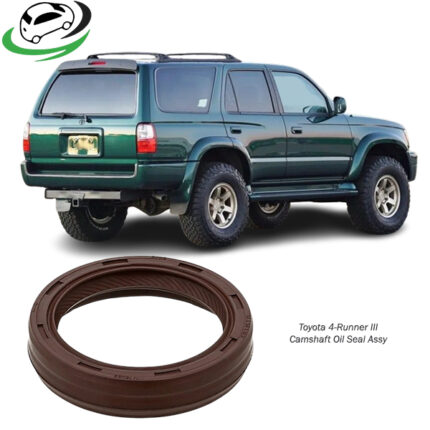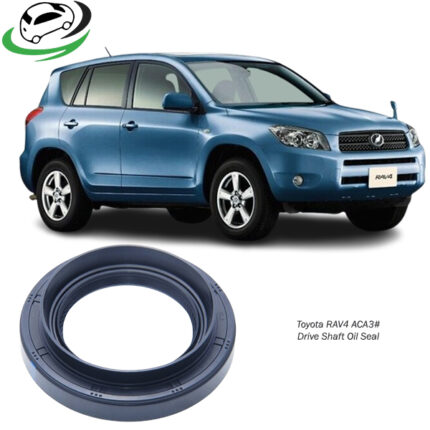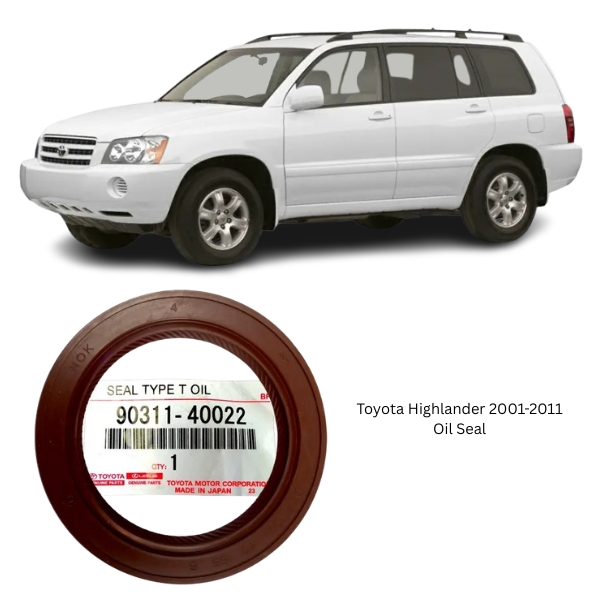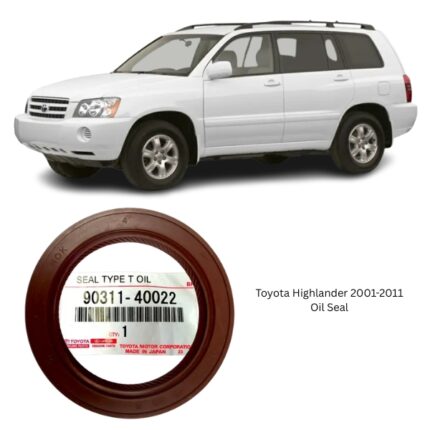Get Toyota Highlander 2001-2011 Oil Seal 90311-40022 in Kenya
Oil seals, also known as oil or shaft seals, are critical components in various mechanical systems, particularly in internal combustion engines and machinery. These seals play a vital role in preventing lubricant leakage, ensuring the efficient operation of the equipment, and protecting internal components from contamination. This comprehensive guide will explore the purpose, design, types, benefits, installation, maintenance, and troubleshooting of oil seals.
1. Purpose of Oil Seals
Oil seals serve several essential functions in machinery and automotive applications:
a. Preventing Lubricant Leakage
The primary function of an oil seal is to prevent lubricants (such as oil or grease) from leaking out of the system. This is crucial for maintaining proper lubrication, which reduces friction and wear on moving parts.
b. Contamination Prevention
Oil seals prevent contaminants, such as dirt, dust, water, and debris, from entering the machinery. Keeping these particles out is essential for protecting internal components and prolonging the life of the equipment.
c. Maintaining Pressure
In many applications, oil seals help maintain the internal pressure of the system. By creating a tight seal, they prevent the escape of gases and vapors, contributing to optimal performance and efficiency.
2. Design and Construction of Oil Seals
Oil seals are designed to provide effective sealing and durability. Understanding their construction helps in appreciating their functionality.
a. Material Composition
Oil seals are typically made from a variety of materials, including:
- Rubber: Commonly used due to its flexibility, resilience, and resistance to oil and temperature variations. Nitrile rubber (NBR) is a popular choice for oil seals.
- Polyurethane: Known for its durability and resistance to abrasion and tearing, making it suitable for heavy-duty applications.
- PTFE (Teflon): Used in high-temperature applications, PTFE seals provide excellent chemical resistance and low friction properties.
b. Design Features
- Shape and Size: Oil seals come in various shapes and sizes to fit different applications. Their dimensions are critical for ensuring a proper fit around the rotating shaft.
- Seal Lip: The seal lip is the part of the oil seal that contacts the shaft. It is typically designed to be flexible, allowing it to create a tight seal while accommodating any shaft movement.
- Spring: Many oil seals feature a metal or rubber spring that provides additional tension to the seal lip, enhancing its ability to maintain contact with the shaft and prevent leaks.
- Outer Diameter: The outer diameter of the oil seal is designed to fit into the housing or bore of the machine, providing a secure installation that prevents leaks.
3. Types of Oil Seals
Oil seals come in various types, each designed for specific applications. Some common types include:
a. Rotary Oil Seals
Rotary oil seals are designed for applications where a shaft rotates within a bore. They are commonly used in engines, gearboxes, and pumps. These seals typically feature a single or double lip design and are available in various sizes to fit different shaft diameters.
b. Static Oil Seals
Static oil seals are used in applications where there is no relative motion between the sealing surfaces. They are commonly found in hydraulic systems and are designed to prevent leakage between stationary components.
c. Radial Oil Seals
Radial oil seals are designed to seal around rotating shafts and are typically used in automotive and industrial applications. They can be made from various materials and are available in different configurations, such as single-lip or double-lip designs.
d. Face Seals
Face seals are used in applications where two surfaces slide against each other. These seals create a barrier to prevent leakage between the two surfaces. They are commonly found in pumps and compressors.
4. Benefits of Using Oil Seals
Utilizing oil seals in machinery and automotive applications offers numerous advantages:
a. Leak Prevention
Oil seals effectively prevent leakage of lubricants, helping to maintain the required oil levels in the system. This is crucial for proper lubrication and overall performance.
b. Contaminant Protection
By keeping contaminants out, oil seals help protect sensitive internal components from damage. This contributes to the longevity of the equipment and reduces maintenance needs.
c. Improved Efficiency
With proper sealing, oil seals help maintain optimal lubrication and reduce friction. This leads to improved energy efficiency and overall performance of the machinery or engine.
d. Cost Savings
By preventing leaks and reducing wear on internal components, oil seals contribute to lower maintenance and repair costs. Regularly replacing worn seals can save significant expenses in the long run.
5. Installation of Oil Seals
Proper installation of oil seals is essential for ensuring their effectiveness and longevity. Here’s a step-by-step guide for installing oil seals:
a. Tools Required
Before starting the installation, gather the necessary tools:
- Seal driver or installer tool
- Rubber mallet or hammer
- Cleaning supplies (solvent, rag)
- Safety goggles and gloves
b. Preparation
- Safety First: Ensure the equipment is powered down, and the area is clean. Wear safety goggles and gloves for protection.
- Remove Old Seal: If replacing an old oil seal, carefully remove it using a seal puller or flathead screwdriver. Be cautious not to damage the surrounding components.
c. Clean the Area
Before installing the new seal, thoroughly clean the sealing surface and the bore where the seal will be installed. Remove any dirt, debris, or old sealant.
d. Lubricate the Seal Lip
Apply a thin layer of oil or grease to the lip of the new oil seal. This lubrication helps the seal slide into place without damage and aids in creating a tight seal.
e. Install the New Oil Seal
- Position the Seal: Align the oil seal with the bore and gently press it into place. Ensure the seal is positioned evenly and flush with the surrounding surface.
- Use a Seal Driver: If available, use a seal driver or installer tool to press the seal into place evenly. Tap gently with a rubber mallet to ensure it is seated properly.
f. Reassemble Components
After the oil seal is securely installed, reassemble any components that were removed during the installation process. Ensure all fasteners are tightened to the manufacturer’s specifications.
6. Maintenance Tips for Oil Seals
Regular maintenance of oil seals is crucial for ensuring their longevity and effectiveness. Here are some maintenance tips:
a. Regular Inspections
Conduct regular inspections of oil seals for signs of wear, damage, or leakage. Early detection of issues can help prevent more significant problems.
b. Monitor Fluid Levels
Keep an eye on lubricant levels in the system. Low fluid levels can lead to increased wear on the oil seal and other components.
c. Listen for Noises
Be attentive to any unusual noises from the machinery, such as grinding or whining sounds, which may indicate issues with the oil seal or other components.
d. Replace Worn Seals Promptly
If inspections reveal significant wear or damage, replace the oil seal promptly to prevent oil leaks and potential damage to internal components.
e. Use Genuine Parts
When replacing oil seals, always opt for genuine or high-quality aftermarket parts to ensure compatibility and performance.
7. Signs of Wear and When to Replace Oil Seals
Understanding the signs of wear is crucial for maintaining the effectiveness of oil seals. Common indicators that an oil seal may need replacement include:
a. Oil Leaks
The most apparent sign of a failing oil seal is the presence of oil leaks. If you notice oil pooling beneath the machinery or engine, it may indicate a compromised seal.
b. Contaminated Lubricant
If the lubricant appears dirty or contaminated, it may suggest that the oil seal is allowing debris to enter the system. Inspect the seal and replace it if necessary.
c. Increased Noise
If the machinery produces increased noise, such as grinding or rattling sounds, it may indicate a problem with the oil seal or related components.
d. Visual Damage
Inspect the oil seal for any visible signs of wear, such as cracks, tears, or deformation. If the seal appears damaged, it should be replaced immediately.
e. Performance Issues
If the machinery exhibits reduced performance or efficiency, it may be due to a failing oil seal. Monitor performance and conduct inspections as needed.
Conclusion
Oil seals are crucial components in various machinery and automotive applications, serving to prevent lubricant leakage, protect against contamination, and maintain internal pressure. Understanding their design, types, benefits, installation, maintenance, and signs of wear can help vehicle owners and operators make informed decisions about their equipment. Regular inspections, timely replacements, and the use of genuine parts are essential for ensuring optimal performance and longevity of oil seals, ultimately contributing to the reliability and efficiency of the machinery they protect. Prioritizing the maintenance of oil seals will enhance overall operational efficiency and prolong the lifespan of the equipment, leading to significant cost savings and reduced downtime.
Follow us on Facebook for more parts.





Reviews
Clear filtersThere are no reviews yet.